November 1958 Popular Electronics
 Table
of Contents Table
of Contents
Wax nostalgic about and learn from the history of early electronics. See articles
from
Popular Electronics,
published October 1954 - April 1985. All copyrights are hereby acknowledged.
|
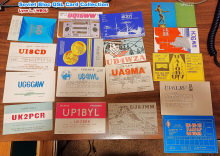
QSL cards from the former Soviet block countries, collected
by long-time DXer, Lynn L. (WB0U), in
the late 1980s. That was the the period when Gorbachev was dissolving the
U.S.S.R.
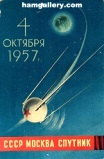 Securing confirmation
of having made a contact (QSL in ham-speak) with a radio operator behind the communist
Iron Curtain was a real achievement during most of the 20th century. Russian and
Chinese citizens were routinely imprisoned for such activity, and if you did manage
to elicit a response to your CQ (request for contact), there was a good chance it
was with a government propagandist posing as a civilian. When
Sputnik 1 was put in orbit on October 4, 1957, a whole new
realm of DXing (long distance communication) opened up by providing satellite relay
paths. Sputnik 1, the world's first artificial satellite, broadcast a series
of pulses at 20.005 and 40.002 MHz that were tracked and reported by both professional
and amateur radio operators. Vital data was learned based on the time and strength
of signals that allowed scientists to ascertain the physics of upper atmosphere
characteristics. Not wanting to give the impression that the assistance of the rest
of the world's capitalist pigs was needed or wanted (although it definitely was),
virtually no acknowledgement was forthcoming from Radio Moscow. This is a story
of one Ham's successful effort to obtain a - in those days (1957), rare - space
route QSL card. The U.S. Army Signal Corps issued QSL cards with their
Project Diana earth-moon-earth (EME) radar experiments. Securing confirmation
of having made a contact (QSL in ham-speak) with a radio operator behind the communist
Iron Curtain was a real achievement during most of the 20th century. Russian and
Chinese citizens were routinely imprisoned for such activity, and if you did manage
to elicit a response to your CQ (request for contact), there was a good chance it
was with a government propagandist posing as a civilian. When
Sputnik 1 was put in orbit on October 4, 1957, a whole new
realm of DXing (long distance communication) opened up by providing satellite relay
paths. Sputnik 1, the world's first artificial satellite, broadcast a series
of pulses at 20.005 and 40.002 MHz that were tracked and reported by both professional
and amateur radio operators. Vital data was learned based on the time and strength
of signals that allowed scientists to ascertain the physics of upper atmosphere
characteristics. Not wanting to give the impression that the assistance of the rest
of the world's capitalist pigs was needed or wanted (although it definitely was),
virtually no acknowledgement was forthcoming from Radio Moscow. This is a story
of one Ham's successful effort to obtain a - in those days (1957), rare - space
route QSL card. The U.S. Army Signal Corps issued QSL cards with their
Project Diana earth-moon-earth (EME) radar experiments.
QSL from Sputnik
 How one SWL managed to get his prized space verification How one SWL managed to get his prized space verification
By C. M. Stanbury, II
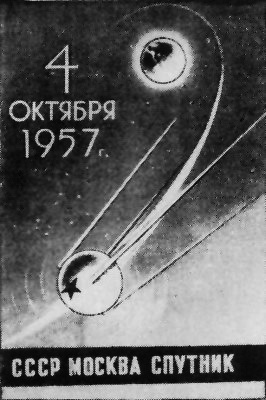
Have you heard Sputnik? Yes. Have you received your QSL? Unless you live on the
other side of the iron curtain, chances are pretty good you haven't. Despite the
fact that Radio Moscow has repeatedly asked for reports on the Soviet satellites,
until now the highly prized space-QSL's have not been crossing the "red divide."
What's needed to verify Sputnik? An address? Yes, that will help a little. How
about transmission data to prove your reception ? Yes, knowing how to get this is
essential. But even more important is your approach. Without the proper approach,
a DX'er is a very dead duck so far as Sputnik verifies are concerned.
The Proper Approach. The key word of this approach is frankness.
Most of you know that the opposite seems to be the standard for at least 90% of
the broadcasts coming from Radio Moscow. The same evasiveness carries over into
their handling, of DX reports. The following excerpt is typical.
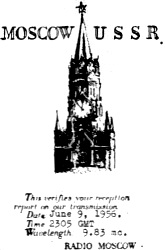 The call letters of the Chinese language
transmission you heard are the same as the ones used for the North American broadcasts
- the first bars of Dunaevsky's "Song of the Motherland." The call letters of the Chinese language
transmission you heard are the same as the ones used for the North American broadcasts
- the first bars of Dunaevsky's "Song of the Motherland."
To meet this kind of thing with more evasion would result in an endless series
of correspondence which would net the DX'er nothing but propaganda. On the other
hand, following a straight-line approach, cutting through the Soviet curves, will
- nine chances out of ten - bring you what you are after.
The following are the final paragraphs of the letter that brought home my SPUTNIK
QSL.
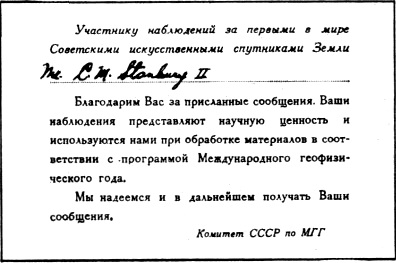 I am going to speak frankly. Even if you had
not promised to verify reception of your Sputniks, it would be an act of bad faith
not to do so. Many listeners all over the world took the time and trouble to receive
and report reception of your satellites. They certainly deserve QSL cards or letters
for their efforts. I am going to speak frankly. Even if you had
not promised to verify reception of your Sputniks, it would be an act of bad faith
not to do so. Many listeners all over the world took the time and trouble to receive
and report reception of your satellites. They certainly deserve QSL cards or letters
for their efforts.
Thank you very much for the cards and letters you have sent me in the past.
I do hope you or somebody else will correct this most unfortunate QSL situation.
Radio Moscow, like any other International Short-Wave Service is dependent upon
the world's SWL's. A letter such as that above would seem to leave them very little
choice but to fulfill their obligations. You'll note, however, that the letter is
courteous. Any station has the right to ignore a rude or insulting DX report.
Transmission Data. You will need transmission data to prove
your reception. Easiest to obtain are the number of beeps per minute. Merely count
the beeps in a 30-second period and multiply by two.
If you have a slightly musical ear, you can make your report considerably better.
Estimate the modulation frequency by comparing the Sputnik signal with the alternate
440- and 600-cps tones transmitted by Station WWV.
If your receiver is poorly calibrated on the upper short-wave frequencies, the
WWV signal on 20,000 kc. can be used to zero in the satellite's frequency of 20,005
kc. First locate WWV. If the signal is strong, tune to its upper edge. If WWV is
being received weakly, tune just above the edge. In either case, retune every 10
or 15 minutes (unless WWV has disappeared) to decrease the danger of missing the
Sputnik if you are slightly off frequency or if your receiver is drifting.
Where to Report. If you have already sent a report either in
care of Radio Moscow or to The USSR Committee on the International Geophysical Year,
wait one month for a reply.
If you have not yet sent a report, send your first one to the committee and wait
three months. Make this a standard report with a casual request for a QSL.
If you do not get results, send a second report to: Eugenia Stepanove, North
American Service, Radio Moscow. Ask her to forward it to the proper agency and say
why you think you deserve a QSL.
Posted September 1, 2022
(updated from original post on 2/11/2013)
|










 How one SWL managed to get his prized space verification
How one SWL managed to get his prized space verification 
 The call letters of the Chinese language
transmission you heard are the same as the ones used for the North American broadcasts
- the first bars of Dunaevsky's "Song of the Motherland."
The call letters of the Chinese language
transmission you heard are the same as the ones used for the North American broadcasts
- the first bars of Dunaevsky's "Song of the Motherland."  I am going to speak frankly. Even if you had
not promised to verify reception of your Sputniks, it would be an act of bad faith
not to do so. Many listeners all over the world took the time and trouble to receive
and report reception of your satellites. They certainly deserve QSL cards or letters
for their efforts.
I am going to speak frankly. Even if you had
not promised to verify reception of your Sputniks, it would be an act of bad faith
not to do so. Many listeners all over the world took the time and trouble to receive
and report reception of your satellites. They certainly deserve QSL cards or letters
for their efforts. 